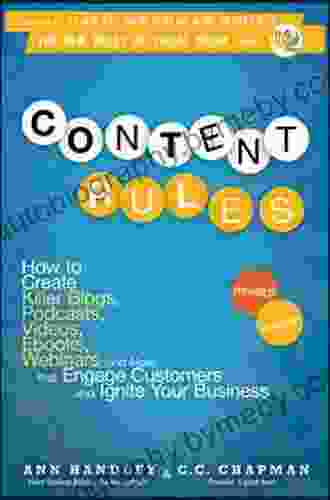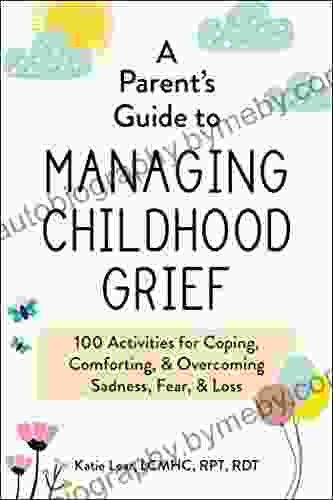100 Activities for Coping, Comforting, and Overcoming Sadness, Fear, and Loss

Everyone experiences sadness, fear, and loss at some point in their lives. These emotions can be overwhelming and difficult to cope with. This book offers 100 activities to help you process your emotions, develop coping mechanisms, and find comfort and healing.
4.3 out of 5
| Language | : | English |
| File size | : | 2078 KB |
| Text-to-Speech | : | Enabled |
| Screen Reader | : | Supported |
| Print length | : | 304 pages |
The activities in this book are divided into four sections:
- Coping with Sadness
- Coping with Fear
- Coping with Loss
- Finding Comfort and Healing
Each section contains a variety of activities, including:
- Writing exercises
- Art activities
- Movement activities
- Mindfulness activities
- Self-care activities
You can choose the activities that appeal to you most and that fit your current needs. There is no right or wrong way to use this book. You can work through the activities in Free Download, or you can skip around and choose the ones that resonate with you most.
Coping with Sadness
Sadness is a normal human emotion. It can be caused by a variety of factors, such as loss, disappointment, or failure. Sadness can range from mild to severe, and it can last for a short period of time or for a long time.
There is no right or wrong way to feel sad. It is important to allow yourself to experience your sadness and to grieve in your own way. However, if your sadness is severe or persistent, it is important to seek professional help.
The activities in this section are designed to help you cope with sadness. They can help you to process your emotions, develop coping mechanisms, and find comfort and healing.
Activities
- Write a letter to your sadness. In your letter, tell your sadness what you are feeling and how it is affecting your life. You can also ask your sadness questions about why it is here and what you can do to make it go away.
- Draw or paint a picture of your sadness. What does your sadness look like? What colors and shapes does it have? What does it feel like to touch?
- Create a collage of images that represent your sadness. You can use magazine clippings, photographs, or your own drawings. Arrange the images in a way that expresses how you are feeling.
- Write a poem or song about your sadness. Express your feelings through words and music.
- Take a walk or hike in nature. Being in nature can help to reduce stress and anxiety, and it can provide you with a sense of peace and tranquility.
- Spend time with loved ones. Talking to someone who cares about you can help you to feel supported and loved. It can also help you to see your situation from a different perspective.
- Do something that makes you happy. This could be anything from reading a book to watching a movie to spending time with friends.
- Practice self-care. This means taking care of your physical and emotional health. Eat healthy foods, get enough sleep, and exercise regularly.
Coping with Fear
Fear is a normal human emotion. It is a response to danger or threat. Fear can be caused by a variety of factors, such as real danger, perceived danger, or past trauma.
Fear can range from mild to severe, and it can last for a short period of time or for a long time. Fear can have a significant impact on your life. It can make you feel anxious, stressed, and avoidant. It can also interfere with your relationships, work, and school.
If your fear is severe or persistent, it is important to seek professional help. However, there are also a number of things you can do on your own to cope with fear.
The activities in this section are designed to help you cope with fear. They can help you to understand your fear, develop coping mechanisms, and find comfort and healing.
Activities
- Identify your fears. What are you afraid of? Once you know what you are afraid of, you can start to develop strategies for coping with it.
- Write about your fears. This can help you to process your emotions and to gain a different perspective on your fears.
- Draw or paint a picture of your fears. What do your fears look like? What colors and shapes do they have? What do they feel like to touch?
- Create a collage of images that represent your fears. You can use magazine clippings, photographs, or your own drawings. Arrange the images in a way that expresses how you are feeling.
- Talk to someone you trust about your fears. Talking to someone who cares about you can help you to feel supported and loved. It can also help you to see your situation from a different perspective.
- Practice relaxation techniques. Relaxation techniques can help to reduce stress and anxiety, and they can make it easier to cope with fear.
- Face your fears gradually. Don't try to do too much at once. Start by facing your fears in small steps. As you become more comfortable, you can gradually increase the challenge.
- Reward yourself for your progress. As you face your fears and make progress, it is important to reward yourself. This will help you to stay motivated and to keep moving forward.
Coping with Loss
Loss is a normal part of life. Everyone experiences loss at some point, whether it is the loss of a loved one, a job, or a home. Loss can be a difficult and painful experience. It can lead to a variety of emotions, such as sadness, anger, guilt, and fear.
The grieving process is different for everyone. There is no right or wrong way to grieve. It is important to allow yourself to experience your grief in your own way and in your own time.
The activities in this section are designed to help you cope with loss. They can help you to process your emotions, develop coping mechanisms, and find comfort and healing.
Activities
- Write a letter to the person or thing you have lost. In your letter, tell them what you are feeling and how you are coping. You can also ask them questions about why they are gone and what you can do to make the pain go away.
- Draw or paint a picture of the person or thing you have lost. What did they look like? What colors and shapes did they have? What did they feel like to touch?
- Create a collage of images that represent the person or thing you have lost. You can use magazine clippings, photographs, or your own drawings. Arrange the images in a way that expresses how you are feeling.
- Write a poem or song about the person or thing you have lost. Express your feelings through words and music.
- Talk to someone you trust about your loss. Talking to someone who cares about you can help you to feel supported and loved. It can also help you to see your situation from a different perspective.
- Join a support group. Support groups can provide you with a safe and supportive environment to share your experiences and to learn from others who have experienced similar losses.
- Practice self-care. This means taking care of your physical and emotional health. Eat healthy foods, get enough sleep, and exercise regularly.
Finding Comfort and Healing
After experiencing sadness, fear, or loss, it is important to find comfort and healing. This can take time and effort, but it is possible to move on from these experiences and to live a happy and fulfilling life.
4.3 out of 5
| Language | : | English |
| File size | : | 2078 KB |
| Text-to-Speech | : | Enabled |
| Screen Reader | : | Supported |
| Print length | : | 304 pages |
Do you want to contribute by writing guest posts on this blog?
Please contact us and send us a resume of previous articles that you have written.
 Book
Book Novel
Novel Page
Page Chapter
Chapter Text
Text Story
Story Genre
Genre Reader
Reader Library
Library Paperback
Paperback E-book
E-book Magazine
Magazine Newspaper
Newspaper Paragraph
Paragraph Sentence
Sentence Bookmark
Bookmark Shelf
Shelf Glossary
Glossary Bibliography
Bibliography Foreword
Foreword Preface
Preface Synopsis
Synopsis Annotation
Annotation Footnote
Footnote Manuscript
Manuscript Scroll
Scroll Codex
Codex Tome
Tome Bestseller
Bestseller Classics
Classics Library card
Library card Narrative
Narrative Biography
Biography Autobiography
Autobiography Memoir
Memoir Reference
Reference Encyclopedia
Encyclopedia Andrew J Hoffman
Andrew J Hoffman Gail Lumet Buckley
Gail Lumet Buckley Angela Eckhoff
Angela Eckhoff Andrew Sharples
Andrew Sharples Andy Rooney
Andy Rooney Ann Garrett
Ann Garrett Angela Ardis
Angela Ardis Angus Waycott
Angus Waycott Anil Kumar
Anil Kumar Andre Campbell
Andre Campbell Ron Suskind
Ron Suskind Eneasz Brodski
Eneasz Brodski Andrew Pacholyk
Andrew Pacholyk Becca Riley
Becca Riley Cathy Barrow
Cathy Barrow David Tracey
David Tracey Timothy Dalrymple
Timothy Dalrymple Matthew Parrish
Matthew Parrish Amy D Morse
Amy D Morse Andrea Falk
Andrea Falk
Light bulbAdvertise smarter! Our strategic ad space ensures maximum exposure. Reserve your spot today!

 Christian BarnesUnleash Your Inner Superhero: Lair Superhero Litrpg Adventure Henchman Book...
Christian BarnesUnleash Your Inner Superhero: Lair Superhero Litrpg Adventure Henchman Book...
 Tom HayesUnveiling the Secrets of Imperial Concealment: A Comprehensive Review of "How...
Tom HayesUnveiling the Secrets of Imperial Concealment: A Comprehensive Review of "How... Elton HayesFollow ·10.6k
Elton HayesFollow ·10.6k Milan KunderaFollow ·13k
Milan KunderaFollow ·13k Ronald SimmonsFollow ·5.7k
Ronald SimmonsFollow ·5.7k Diego BlairFollow ·14.6k
Diego BlairFollow ·14.6k Bernard PowellFollow ·17k
Bernard PowellFollow ·17k Joseph ConradFollow ·3.6k
Joseph ConradFollow ·3.6k Kazuo IshiguroFollow ·10.6k
Kazuo IshiguroFollow ·10.6k Tyrone PowellFollow ·5.7k
Tyrone PowellFollow ·5.7k

 Bryce Foster
Bryce FosterCelebrate the Luck of the Irish: Unveiling Saint...
As the verdant hues of spring brush...

 Chase Simmons
Chase SimmonsCody Rodeo: A Photographic Journey into the Heart of the...
Step into the arena of the...

 David Mitchell
David MitchellUnveiling the Enchanting World of Door County Quilts: A...
Step into the Heart of Amish Country in...

 Floyd Powell
Floyd PowellCowboy Chatter: Unraveling the Enigmatic Tales of the Old...
Step into the...

 Ismael Hayes
Ismael HayesUnlock Content Marketing Mastery: How to Create...
In today's digital landscape, content is...

 Boris Pasternak
Boris PasternakMore Than 200 Hardball Questions For The Thinking Fan
The Ultimate Baseball Trivia Challenge Are...
4.3 out of 5
| Language | : | English |
| File size | : | 2078 KB |
| Text-to-Speech | : | Enabled |
| Screen Reader | : | Supported |
| Print length | : | 304 pages |








